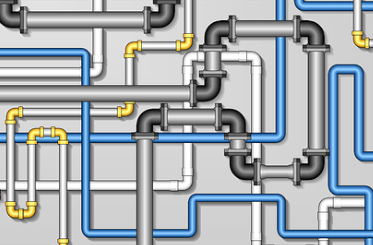Ice Pigging for Clean Pipes
Published on by Marina A, Previously Key Account and Content Manager at AquaSPE AG in Technology
Ice pigging is the infusion of slurry ice into pipes to puch, wipe away and carry out loose material and particles from the inside of the pipes. It is low-risk pipe cleaning method which combines flushing and forcing solid objects through the pipe.
Ice pigging was patented by Professor Joe Quarini of the University of Bristol.
 The flowless pipe is isolated from the mains pressure by a closed valve. An ice-water slurry, of 50-90% ice fraction, is then injected into the pipe. The upstream valve is fully open to provide the pressure which will enable the cleaning.
The flowless pipe is isolated from the mains pressure by a closed valve. An ice-water slurry, of 50-90% ice fraction, is then injected into the pipe. The upstream valve is fully open to provide the pressure which will enable the cleaning.
Since the icy slurry has properties similar to both those of a liquid (ice is pumped as a liquid) and solid (cleaning properties of solids forced through pipes), if efficiently removes the sediments and biofilms from the pipe.
As ice passes through the pipe, it adjusts to the size and shape of the pipe, providing very efficient cleaning.
After the ice passes through the pipe, the pipe is flushed for a short period.
The process will not in any way damage the pipes and there is no risk of anything getting stuck in the pipes – if ice does get stuck, it will simply melt.
The wall shear of pushing ice though the pipes is two to four orders of magnitude higher in comparison to the wall shear flushing water through the pipe would be able to achieve at the same speed.
Ice pigging is a quick pipe cleaning process, in comparison to other methods.
It does not require any type of pretreatment nor excavation since the ice is injected through existing access points.
It requires less water than other pipe cleaning methods (1.5 times the volume of the pipe -> one pipe volume for cleaning with ice and 0.25 or 0.5 for flushing), but more energy to cool the ice and keep it chilled until it is injected in the pipes.
Ice pigging can be applied in different kinds of industries and is extremely efficient in removing greasy and highly viscous products (e.g. mayonnaise in the food industry).
Sources:
· Investigation and development of an innovative pigging technique for the water supply industry.
G. Quarini, E. Ainslie, M. Herbert, T. Deans, Dom Ash+ , D Rhy , N. Haskins, G. Norton, S. Andrews and M. Smith
University of Bristol Bristol Water plc
· https://en.wikipedia.org/wiki/Ice_pigging
· https://www.ice-pigging.com/en/applications/1/drinking-water
Media
Taxonomy
- Infrastructure
- Pipeline
- Utility Pipe Network
- Pipeline Installation & Maintenance
- Pipeline Rehabilitation
- Pipelines
2 Comments
-
Hi Guy McGowen. In Australia, the disposal of the ice pigging waste is never put back into the potable water system. Instead it is carried out in the following ways:
1. In areas where there is an, ocean outfall sewer treatment plant, we are able to put the ice waste through the sewer system.
2. For inland areas where the sewer treatment plant outlet is directed to a river the salt content of the ice makes it unwise to dispose through the plant.
3. In these areas we use the drying beds of a water treatment plant. These drying beds collect the filtered products from treating the water, it is dried out and disposed of in a number of ways, sometimes in land remediation or landfilled.
For a more comprehensive overview of SUEZ’s use of ice pigging technology, read more here: http://bit.ly/2iVddK7
-
May I ask what is the final deposition of the slurry with the pipe innards waste. If I may suggest that RNA microbial use will never allow any waste particles which need cleaning later. In addition the final deposition of the cleaned pipes is your choice. 1. pump back into the potable drinking water system. 2. repurpose for any other lawn care or AG use. 3. allow it to flow into streams to ocean which it will continue cleaning for a few weeks . I really like the way you think. Need more thinkers like you on this thread.